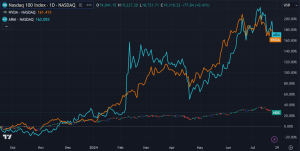Stay within your circle of competence. Look for opportunities that others might be overlooking.
Those are some of the key strategies employed by Amelia Weir, who helps manage the Paradigm Select Fund
PFSLX,
which has significantly beaten its benchmark and competing funds over the medium term, according to Morningstar.
I recently caught up with Weir, who works at Albany, N.Y.-based Paradigm Capital Management, to learn about investing and favored stocks for us to consider owning.
I summarize five lessons, below, and include nine stocks as examples. The stocks look interesting, in part, because they are of high conviction. Each represent 3% to 4.5% of in her portfolios — which makes them “overweight” positions.
Let’s take a look.
Lesson #1: Think different
If it helped Steve Jobs, it can help us as investors, too. In fact, to think different — the ability to stand apart from groupthink — is a common trait among successful investors.
That probably comes naturally for Weir, given her atypical path into investing. She graduated with honors from Harvard College in literature, and then began her career in investing by editing brokerage notes. Next, she scored a job in stock analysis at Bear Stearns. Along the way, she honed core analytical skills with an MBA from the Wharton School at the University of Pennsylvania.
The upshot? Her roots as an industry outsider probably help her view selloffs as buying opportunities instead of joining the panic selling. One “trick” that will help you here is to simply think long term. Put a different way, resist the temptation to be a market timer. This seems easy on paper but to do this right, you have to make two decisions correctly — the exit and the re-entry.
“Even in a sharp downturn, you can’t afford to go to cash, because if you miss the early days of the snapback, you miss a lot of the move,” she says.
The current market action in her small- and medium-cap (smidcap) space offers a timely example. While narrow indices like the S&P 500
SPX,
and the Dow Jones Industrial Average
DJIA,
bump along near all-time highs, the Russell 2000 Index
RUT,
was recently in a correction (defined as down at least 10%).
One name from her portfolio that might be worth considering in the weakness: Addus HomeCare
ADUS,
in home health-care services. It’s down 30% from highs earlier this year, in part because of concerns about the impact of the delta variant on business. But demographics work in its favor, and the company has the strong balance sheet that Weir likes to see.
Another example: AtriCure
ATRC,
which sells devices used by surgeons perform ablation to treat atrial fibrillation. AtriCure is down nearly 14% from recent highs, but Weir likes the company because it has no direct competitors, and the potential market size is huge.
Lesson #2: Favor smid-caps
Smidcaps get less attention. So you have to do more original work. But that’s also what makes them more attractive. Because they are under-followed and underappreciated, you’re more likely to find bargains. Here are three names Weir singles out from among the top holdings as examples.
Cross Country Healthcare
CCRN,
offers recruiting and staffing services in health care. Co-founder Kevin Clark returned in 2019 to serve as CEO. Since then, the company has made a lot of progress deploying technology to get up to speed with competitors. “But it is not done yet,” says Weir. The company benefits from the aging of the population, and nursing shortages.
Next, consider RadNet
RDNT,
an outpatient diagnostic imaging company. RadNet is deploying artificial intelligence and machine learning to help radiologists. Its stock has been held back by concerns about declining patient visits due to Covid. But this negative won’t last forever.
Meanwhile, RadNet has been using its strong balance sheet to make regular acquisitions — 15 of them in the first half of this year. RadNet also gets a lift because its rates can be lower than those charged by hospitals for similar services.
Third, consider Kulicke & Soffa
KLIC,
which offers assembly equipment used in the chip space. A lot of investors might think the pull forward in demand because of the chip shortage is peaking. But they are overlooking the rollout of several new versions of the company’s product line, says Weir.
Weir has skills in the smidcap space. Her Paradigm Select fund beats its mid-cap blend category and Russell Midcap Index benchmark by 4 to 7.9 percentage points annualized over the past three to five years, according to Morningstar. Her Paradigm Value Fund
PVFAX,
and Paradigm Micro-Cap Fund
PVIVX,
show similar outperformance.
Lesson #3: Favor companies with strong free cash flow
This is one I hear time and again from portfolio managers who beat their benchmarks. “Good free cash flow allows a company to control its own destiny in tough times, like spring of 2020,” says Weir.
Companies with strong free cash flow and balance sheets can benefit during hard times by taking advantage of market weakness to repurchase shares and make acquisitions.
As examples from her top holdings, she cites the media and cloud services company J2 Global
JCOM,
which has been using its cash to make tactical acquisitions; the technology staffing company Kforce
KFRC,
which has been using cash to buy back stock; and Builders FirstSource
BLDR,
in home building materials sector.
Builders FirstSource is more than a materials supplier because it offers value-added products like factory-built frames for home construction, which help home builders save on labor costs. It also uses its cash strength on stock buybacks and acquisitions. It recently bought WTS Paradigm, which offers software that helps homebuilders operate more efficiently.
Lesson #4: Know your circle of competence and stay inside it
This comes right out of the teachings of Warren Buffett. But Weir takes it a step further. Not only does she define her circle of confidence, but she also shies away from sectors where she thinks it’s too challenging to ever get an edge. So, while the Oracle of Omaha will invest in banks and energy companies, Weir likes to stay away because their fortunes are too linked to moves in interest rates and commodity prices.
“Those are out of management control, no matter how good they are,” she says.
Her areas of strength? As you can tell from the companies cited above, those include technology and health care.
She also cites industrials. Here, a favorite company is Rexnord
RXN,
It’s in the process of spinning out a division that sells motion-control equipment used in industry. Instead, it will focus on its business division selling devices used in water systems in commercial buildings like hotels, stores, sports arenas and offices. Demand here is driven by the construction boom, and upgrades of systems in older buildings to conserve energy and water.
Lesson #5: A tip to deal with the daily struggle of investing
If investing seems like a constant battle, take comfort in knowing you are not alone.
“It is never easy,” says Weir. “You put in the same effort, but it doesn’t always go your way. Even when we are doing well, I ask, ‘Am I drinking the Kool-Aid? What is going to change? What am I missing?’ ”
The key to making it through tough times and the doubts is to have a system that works more often than not, and sticking to it. “Having a good disciplined process gives you comfort,” she says.
Weir’s system is by no means the only approach around, but it seems to work, given her track record.
You could do worse than to borrow from her playbook.
Michael Brush is a columnist for MarketWatch. At the time of publication, he had no positions in any stocks mentioned in this column. Brush is editor of the stock newsletter, Brush Up on Stocks. Follow him on Twitter @mbrushstocks.
This post was originally published on Market Watch






